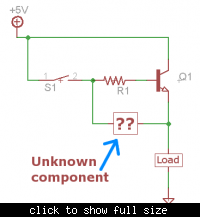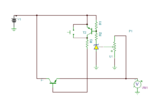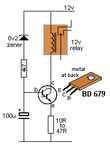lee321987
Member level 5
Hello.
I'm trying to build a low-voltage cut off circuit.
The idea is a momentary switch turns on a transistor which powers the circuit, some (unknown) component in the circuit will instantly begin powering the base of the transistor.
When a certain low voltage is reached this unknown component will stop powering the base of the transistor (i.e. the switch will be required to power on again).
Is there a way to build this with any common components?
Could an LM431 (a.ka. TL431) shunt regulator do it?
Schematic:

I'm trying to build a low-voltage cut off circuit.
The idea is a momentary switch turns on a transistor which powers the circuit, some (unknown) component in the circuit will instantly begin powering the base of the transistor.
When a certain low voltage is reached this unknown component will stop powering the base of the transistor (i.e. the switch will be required to power on again).
Is there a way to build this with any common components?
Could an LM431 (a.ka. TL431) shunt regulator do it?
Schematic:



